Reports have reached that some Master Teachers are not given full teaching loads. Instead, more teaching loads are given to newly hired teachers.
TeacherPH is reminding all concerned to comply strictly with the provisions of DECS Order No. 39, s. 1990 relative to the giving of teaching loads to Master Teachers, Head Teachers, and Special Teachers, particularly paragraph 7, quoted hereunder:
7. Other non-academic teachers shall now be involved in actual teaching as follows:
All teachers on detail in non-DECS and DECS offices shall be recalled and given corresponding teaching loads.
a. Special teachers, head teachers and principals I shall also be assigned teaching loads as follows:
1. Librarian, canteen teachers, guidance and property custodians in a school with a student population of 2,000 and above shall not be given teaching loads. All the rest should be given at least 2 and not beyond 4 teaching loads.
2. School and/or district coordinators should be given corresponding teaching loads of at least 2 and not more than 4 loads.
3. Elementary/secondary school head teachers and department heads and secondary and elementary principals I should be given 2-4 teaching loads if they handle less than 14 teachers.
4. All Master Teachers I and II be given full teaching loads, except those with special projects or researches, in which case a minimum of 4 teaching loads be given.
According to DECS Order No. 57, s. 1997 and MEC Order No. 10, s. 1979 particularly paragraph 7 which states that “the Schools Division Superintendent shall direct principals, district supervisors, and division supervisors to see to it that maximum and optimum use is made of the Master Teachers.”
DECS Order 39, s. 1990, also states that “Master Teachers should concentrate on the given full teaching loads, except those with special projects or researches, in which case a minimum of 4 teaching loads is given.”
PSDS’s should refrain from recommending Master Teachers’ as TIC’s for optimum use of Master Teachers to Teaching-learning activities.
However, if Master Teachers wish to shift into the administrative track, then conditions stipulated in herein attached DECS Order 82, s. 1997, entitled “Revised Guidelines on shifting from Master Teacher Position to Administrative Position and Vice Versa,” be satisfied and adhered to.
Reference:
Rhea Mar A. Angtud, Ed.D., CESO VI
Schools Division Superintendent
Recaredo G. Borgonia
Director IV
Regional Director
READ NEXT: Guidelines in the Ranking of Master Teacher Applicants
Table of Contents
DECS ORDER NO. 39, s. 1990
DEPLOYMENT AND ASSIGNMENT OF PUBLIC SCHOOL TEACHERS
In order to answer the demands of teacher items both in the elementary and secondary schools and in anticipation of a significant increase in enrolment, the following guidelines are hereby formulated effective school year 1990-1991.
These guidelines shall be in conformity with RA 4670, the Magna Carta for Public School Teachers, whereby teachers are allowed a maximum of six hours of actual teaching and that anything beyond shall be compensated by overtime pay or honorarium, correspondingly.
In the computation, however, of actual teaching load a credit of 1 teaching load shall be given to: advisorship of a class, school paper or co-curricular activity. Coaching or handling of special/remedial classes shall be credited on the same scheme.
Organization of classes shall be on a minimum of at least 40 pupils/students per class and a maximum of 55 to ensure quality education. Any fraction after a total of 110 pupils assigned to two classes shall be allowed an organization of another class.
In the case of a new class or of classes in far-flung barrios, a class of 15 pupils shall be allowed. A combination of two grades with 40-55 pupils is encouraged.
As a matter of policy, maximizing the utilization of available resources should be resorted to as follows:
- Primary classes should be on a 1:1 ratio.
- Intermediate classes shall be on a 5:3 or 3:2 ration.
- Secondary teachers load shall be:
- Language and science laboratory teachers be given a minimum of 6 teaching loads but not beyond 8 loads for 40 minute periods and 4 teaching loads for a 60-minute period but not beyond 6 loads.
- Other secondary non languages and laboratory teaching loads shall be at a minimum of seven loads at forty minutes and a maximum of 9 teaching loads or a total of 360 minutes. Subjects taught at one hour or 1-1/2 hours based on the 1973 revised curriculum be guided by the foregoing prescribed teaching loads.
Other non-academic teachers shall now be involved in actual teaching as follows:
- All teachers on detail in non-DECS and DECS offices shall be recalled and given corresponding teaching loads.
- Special teachers, head teachers and principals I shall also be assigned teaching loads as follows:
- Librarian, canteen teachers, guidance and property custodians in a school with a student population of 2,000 and above shall not be given teaching loads. All the rest should be given at least 2 and not beyond 4 teaching loads.
- School and/or district coordinators should be given corresponding teaching loads of at least 2 and not more than 4 loads.
- Elementary/secondary school head teachers and department heads and secondary and elementary principals I should be given 2-4 teaching loads if they handle less than 14 teachers.
- All Master Teachers I and II be given full teaching loads, except those with special projects or researches, in which case a minimum of 4 teaching loads be given.
Effective this school year, central school vacancies should be deployed to remote barangays especially in schools with multigrade and/or combination classes. This can be done divisions/districts wise.
Should there be identified excess teachers in a division, the Regional Director shall submit a recommendation for the transfer of the items to another division within the region upon previous approval by DBM and the DECS. Excess secondary teachers in vocational schools and SUC’s shall be looked into for proper utilization in neighboring schools.
This Office shall release items only after above guidelines have been duly complied with.
All other laws and regulations inconsistent with the provisions of any or all of this Order are hereby rescinded or amended accordingly. Immediate dissemination is urgently requested.
ISIDRO D. CARINO
Secretary
DECS ORDER NO. 82, S. 1997
REVISED GUIDELINES ON SHIFTING FROM MASTER TEACHER POSITION TO ADMINISTRATIVE POSITION AND VICE VERSA
In line with the desire to give teachers of public elementary and secondary schools the opportunity and option tc change career paths they like to pursue, the existing policy on shifting relevant to Master Teachers and Schools Principals shall be revised as follows:
Shifting from the Master Teacher. Teacher’s track to the principal’s track and vice-versa shall be allowed once for both the elementary and secondary school Master Teacher and Principal at any point in the progression levels provided the qualification standards are met and after passing an examination.
The Master Teacher or Principal who desires to shift is ranked with all-other qualified candidates for the equivalent position. The selected candidate should be given opportunities by the Division Superintendent to undergo training on the relevant competencies.
For a Master Teacher I to be able to shift to the Principal’s track and vice-versa at the same level, he/she should have a performance rating of Very Satisfactory in the last two years.
A Master Teacher I can shift to the Principal I track without going down to the level of the Head Teacher provided he/she demonstrates the management competencies required of a Principal I. A Principal I who desires to shift to the Master Teacher’s track shall likewise have to possess the teaching competencies required for Master Teachers at the level of shifting. The qualification requirements at each level of progression for both tracks shall correspondingly be revised to include the competency requirements for each level of the tracks.
When a secondary school Head Teacher decides to shift to the Master teacher position, consideration must be given to subject area specialization.
An assessment, certification and training program shall be conducted by the National Educators Academy of the Philippines to prepare those intending to shift career paths and to certify their competencies.
This revision takes place immediately.
DECS ORDER NO. 57, S. 1997
CAREER PROGRESSION SYSTEM FOR MASTER TEACHERS
DECS Order No. 50, s. 1994
Guidelines for Teaching Assignments in the Intermediate Grades
In order to achieve greater efficiency and economy in the vise of human resources within DECS, beginning with the school year 1995-96 elementary grades teachers shall be assigned to intermediate grade classes at a ratio not exceeding four (4) teachers for every three (3) classes, in order to maximize the use of the limited teacher items available for public schools. The former teacher to class ratios of 3:2 and 5:3 shall be phased out whenever possible, to be replaced by this single standard ratio. No departmentalization shall be undertaken for Grades I to IV under any circumstances.
The allocation of teacher items shall be done in conjunction with the strict restructuring of classes on the basis of a minimum of 15 and a maximum of 56 pupils per class. The maximum of 56 shall be maintained at all times, and classes shall be divided only if they exceed the maximum. Classes with a total curriculum year enrolment of less than 15 shall be integrated into multi-grade classes. For accurate and fast computation, division offices shall obtain copies of the computerized allocation system from their respective regional offices.
No elementary teacher shall be terminated on the basis of the implementation of this prospective policy, but affected teachers may be assigned to other positions in the same elementary school.
Regional directors shall closely monitor and supervise the implementation of this Order.
This Order shall become effective with the school year 1995-1996, and those DECS issuances which may be inconsistent or contradictory with this Order are hereby revoked or modified accordingly, including DECS Order No. 39, s. 1990.
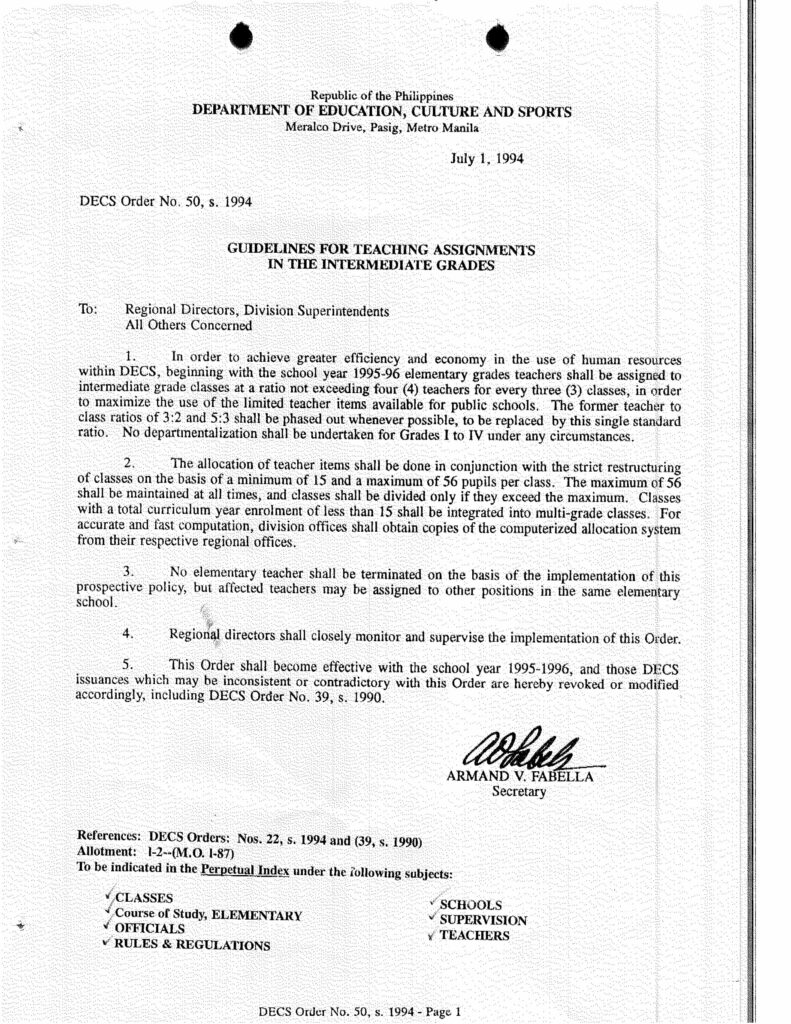

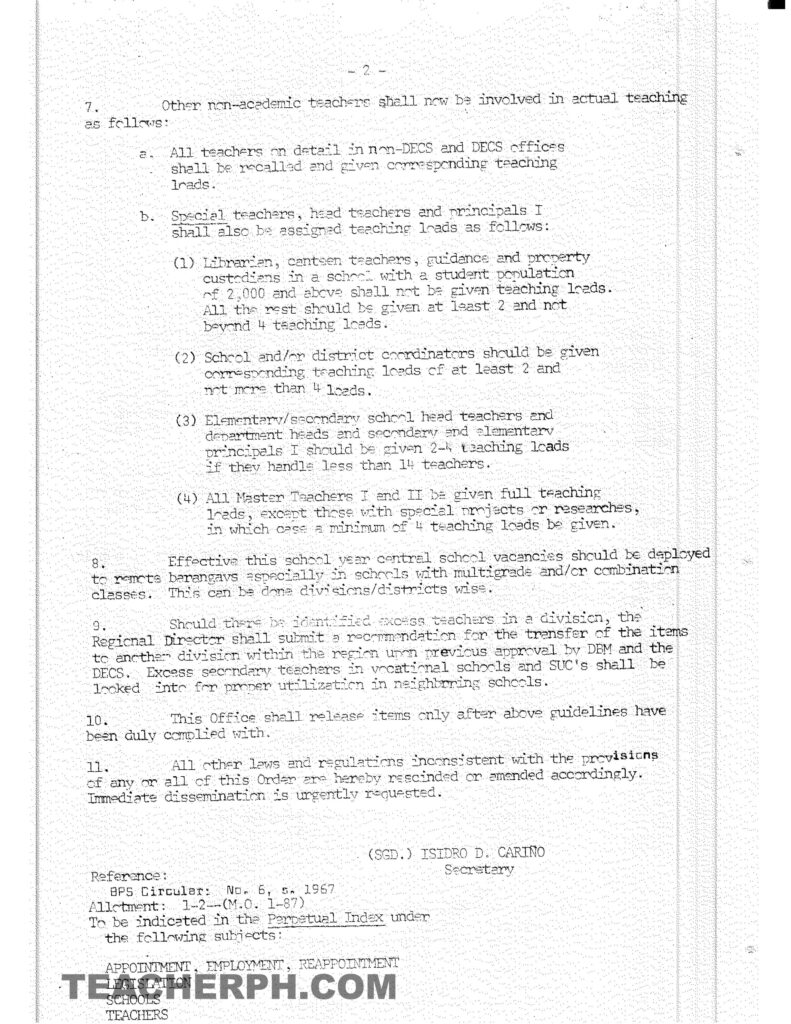
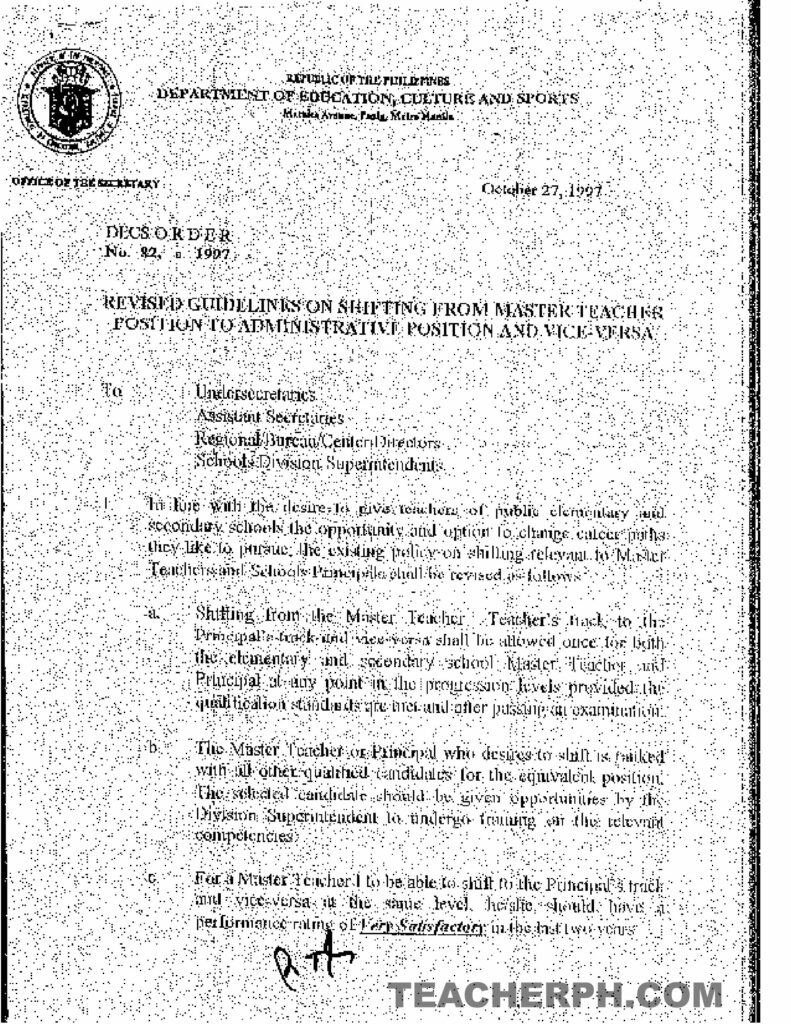
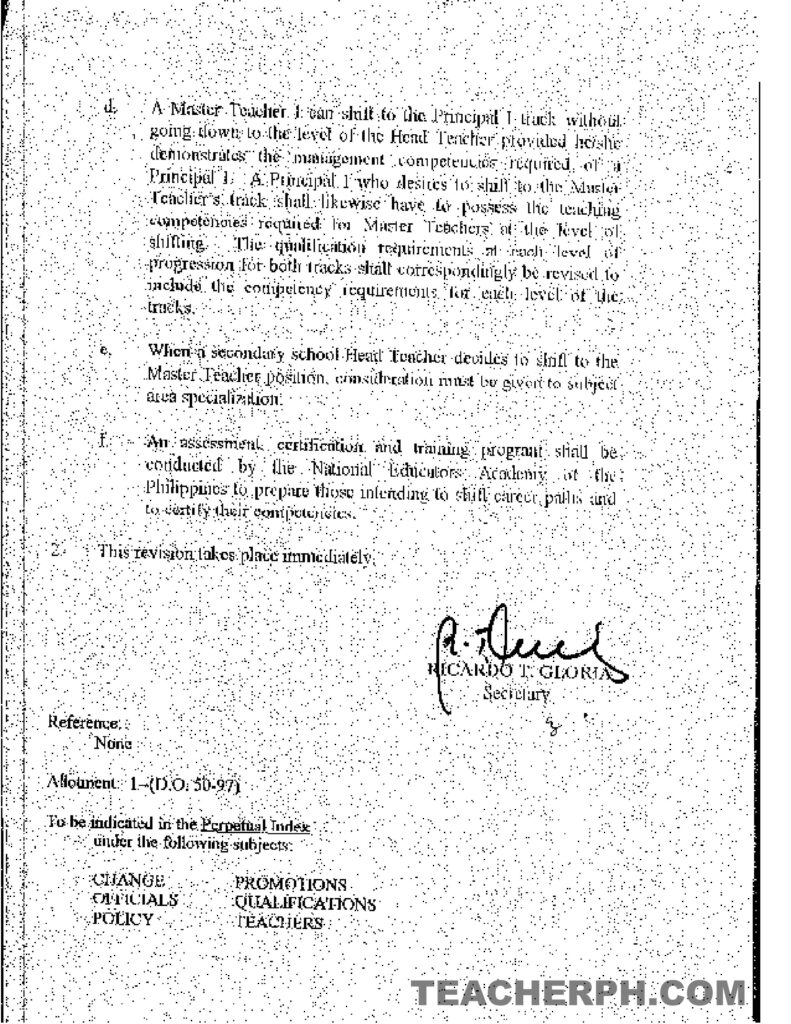


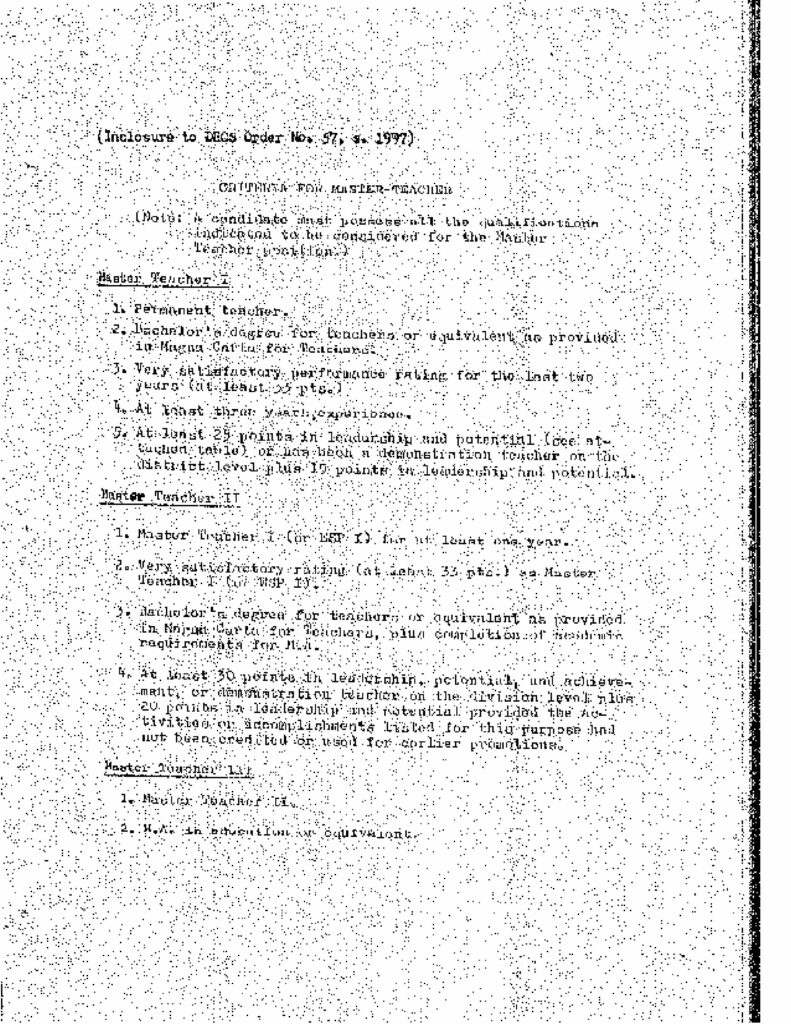

Ano po ang official time ng head teachers? Pwede po makahingi ng basis?
Are head teachers (secondary school) with three (3) teaching loads qualified for Cash allowance formerly known as the Chalk Allowance
Query about qualification of Master Teaching on the assignment of subject area how many years na dapat siya nagtuturo sa subject area para siya maging Master teacher?
My wife is a teacher I can’t grasp how delegation of administrative jobs of a principal can be justified. She has been delegated as a Test and Evaluation coordinator she is suffering much of the grunt of the principal as if my wife is an administrative staff not a teacher. Please enlighten me of why do heads are doing such delegation which takes a lot of time to work on without even thinking that teachers are to teach not do politics of a kind. Is there any compensation that the government should pay my wife by doing administrative jobs on top of teaching. I really hate people using people I think it is a tradition of pnoys to do it when they get on top being lazy and justify by being mean.